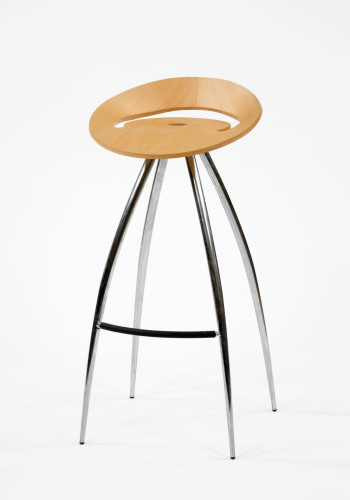103/1999-1
Collection
Furniture
Brief description
'Lyra' stool with chrome legs and a beech-faced moulded plywood seat, designed by Design Group Italia for Magis, Italy, 1994, and retailed through Purves and Purves, London, 1998.
Title
Lyra
Object name
stool
Object number
103/1999-1
Production organisation
Design Group Italia (designer)
Magis (distributor)
Technotubi (manufacturer)
Magis (distributor)
Technotubi (manufacturer)
Production date
1994 (designed)
1998 (manufactured)
1998 (manufactured)
Production place
Italy (designed)
Period
Twentieth century (1900-1999)
Material
steel
chrome
rubber
beech
plywood
chrome
rubber
beech
plywood
Technique
plated
moulded
moulded
Physical description
Lyra stool, with beech-faced plywood seat and chromed tubular steel frame. Seat is circular but has been moulded/steamed so that the front lip faces downwards. The rear of the seat has a C-shaped cut away hole in the wood to create a slightly raised rim/back to the seat. This rim/back has been moulded/steamed to face upwards. The seat has been made out of one piece of wood. In the centre of the seat is a small metal disc, engraved with the words 'LYRA.LYRA.LYRA.LYRA' circling around the edge. This disc acts as a screw which attaches the seat to the stool legs. The stool has four legs which splay out from underneath the seat. Each leg is made of chromed tubular steel, and curves outwards. The feet are smaller than the top of each leg. Joining the front two legs, face on, is a horizontal bar to provide a foot rest. This consists of chromed tubular steel covered with grey rubber. The tips of the legs have rubber feet. The underside of the stool has ' MAGIS / DESIGN GROUP ITALIA LYRA BY TECHNOTUBI MADE...' impressed into the metal underside of the stool.
Dimensions
Height: 87.5cm
Height: 76cm
Diameter: 43cm
Height: 76cm
Diameter: 43cm
Website keywords
seating
Label
Caption for Exploring 20th Century London website:
The 'Lyra' stool designed by Design Group Italia for Magis is made of one piece of moulded plywood, faced with beech, attached to four chrome tapering legs. This example was bought in 1998, four years after it was designed, and it is still in production now in 2008. It has been particularly associated with the loft or warehouse style and has appeared in various glossy magazines and supplements since it was first manufactured, including one article in The Independent on Sunday in 1998 where it graces the rather bare open plan kitchen/living room of a new build shared house in Kensington lived in by three 'young professionals'. Their kitchen cupboards are empty and the space rarely used but one declares to the interviewer "We will entertain when the new dining table arrives…"
Label text for the exhibition At Home with the World, Geffrye Museum (20 March 2012- 9 September 2012):
Stool
This stool, named ‘Lyra’, was first designed in Italy in 1994 by Design Group Italia and is still being made and sold today. For almost 20 years it has enjoyed significant press coverage which emphasizes its enduring popularity with the urban middle classes.
The 'Lyra' stool designed by Design Group Italia for Magis is made of one piece of moulded plywood, faced with beech, attached to four chrome tapering legs. This example was bought in 1998, four years after it was designed, and it is still in production now in 2008. It has been particularly associated with the loft or warehouse style and has appeared in various glossy magazines and supplements since it was first manufactured, including one article in The Independent on Sunday in 1998 where it graces the rather bare open plan kitchen/living room of a new build shared house in Kensington lived in by three 'young professionals'. Their kitchen cupboards are empty and the space rarely used but one declares to the interviewer "We will entertain when the new dining table arrives…"
Label text for the exhibition At Home with the World, Geffrye Museum (20 March 2012- 9 September 2012):
Stool
This stool, named ‘Lyra’, was first designed in Italy in 1994 by Design Group Italia and is still being made and sold today. For almost 20 years it has enjoyed significant press coverage which emphasizes its enduring popularity with the urban middle classes.

